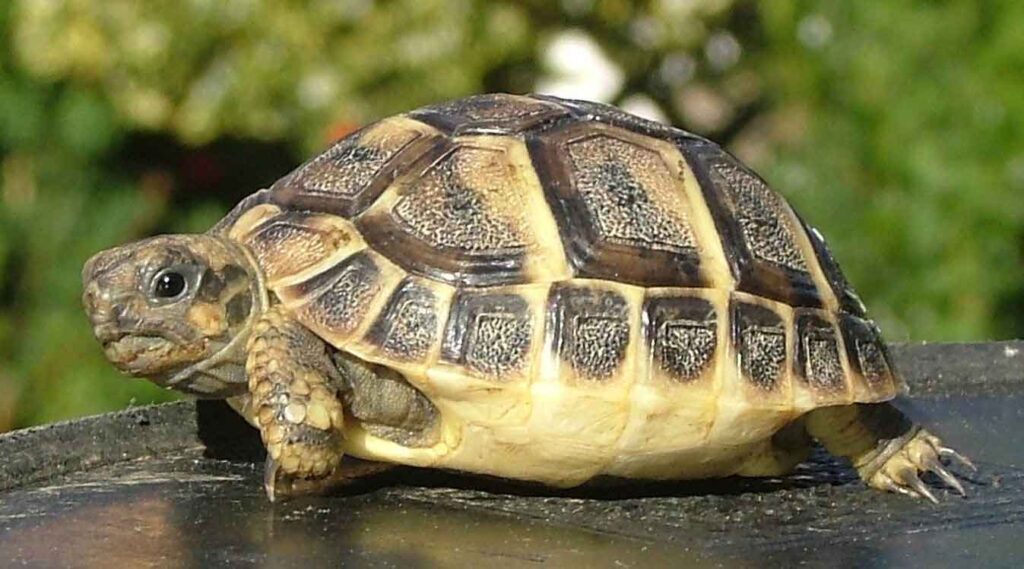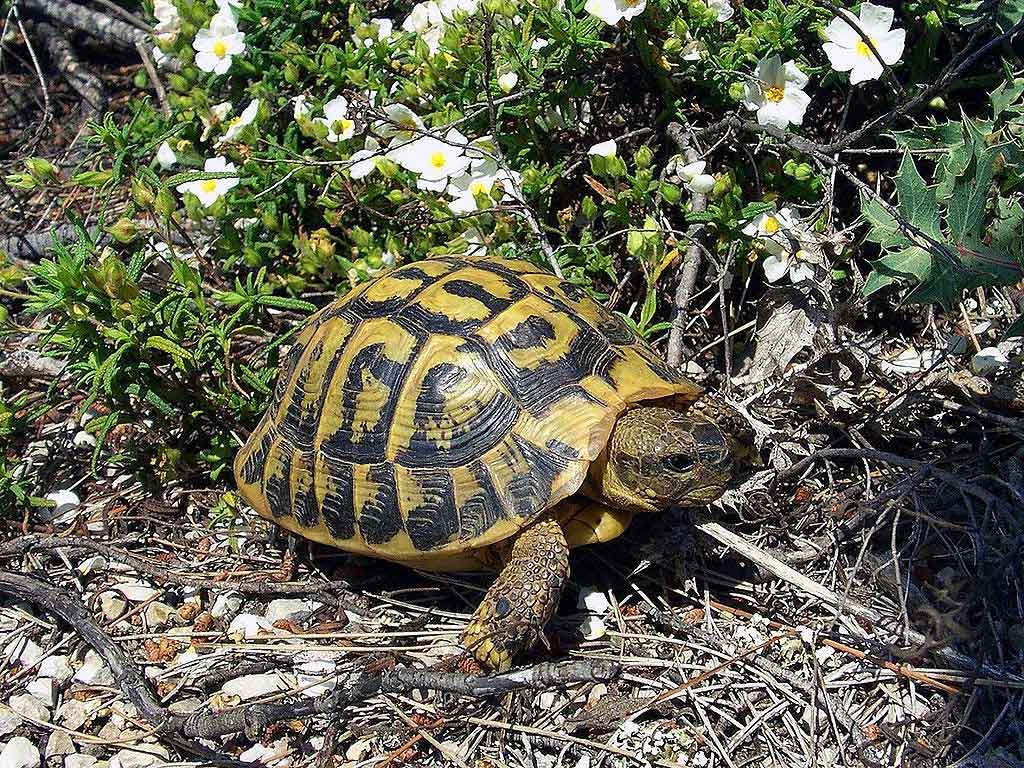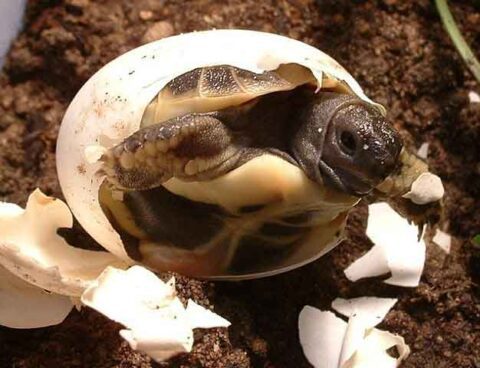
Content |
|---|
Origin
The Hermann's tortoise (Testudo hermanni) has a wide distribution area. It is located in eastern Spain, the south of France, the Balearic Islands, Corsica, Sardinia, Sicily and Southern and Central Italy (Tuscany). The eastern population (Testudo hermanni boettgeri) is located in Serbia, Kosovo, North Macedonia, Romania, Bulgaria, Albania, Turkey and Greece, while the (Testudo hermanni hercegovinensis) populates the coasts of Bosnia and Herzegovina, Croatia and Montenegro.
Characteristics and description
Turtles Testudo hermanni boettgeri grow to 25 cm.. The Testudo hermanni hermanni comes to measure between 15 and 18 cm and is still quite small relative to the other species.
In general, the Hermann's tortoise is a small or medium-sized turtle. The ventral shell of animals is rigid in both males and females. The dorsal shell has a good curvature. A bird's eye view, the Hermann's tortoise appears oval.
A distinctive feature of these turtles is the split tail shield. The color yellow-olive background and black spots on shields distinguish animals. When they are young, the spots can be compared to a “keyhole”. But, marks decline over the years and are barely recognizable as such in old age. Their Paws they have five claws and fairly large scales. In the back, there are only four claws. To distinguish well the Hermann's tortoise of the Greek tortoise (Testudo graeca), note the absence of the horn cone between the tail and hind legs.

sexual characteristics
Males and females have a nail. At the age of four to six years the sexual characteristics of animals are formed. Adult males have a much thicker tail root. It also, males develop a very pronounced nail when they are older. The concave ventral carapace is one of the best features to distinguish the sexes.. Females are heavier than males and also larger. The cloaca of females is closer to the body and the abdominal shell is flat.
Growth of animals
The Hermann's tortoise grows quite linearly during the first six years. Gain approximately one centimeter per year in carapace length. But, after six years growth slows down a bit. The animals then grow around a 30% per year compared to the previous ones. I.e., only 60 to 70 mm. From the tenth to the twelfth year, animals win between a 5 and 15% of growth and weight. The older the animals are, less noticeable the growth of its size. Also the weight almost does not increase. If you feed too much, the animal can also grow much faster. But, this can lead to obesity and organ damage. It also, the shell becomes very developed with humps.
Weight of the “Hermann's tortoise”
Such a turtle, when you have grown up, weighs between 950 and 1100 g.. Animals of up to 1800 g., which however are not too heavy, but they also seem to be somewhat larger. Differences always occur in nature and in captivity and are not a cause for concern. Just animals too much “fat” usually stop being healthy and have weakened organs.
Until the first autumn, the Hermann's tortoise earns approximately the 100% of your birth weight. Animals that were born with 16 g and weigh 32 g in autumn. Especially in the first three months the weight gain is very high, but it also depends on the food available in the outdoor enclosure. For the second autumn, another one is added 50% of the previous weight. And this is how weight gain develops during the first five or six years. Then, it is increasingly reduced until the animals are fully adult.
Habitat
The preferred habitats of the Hermann's tortoise are sunny and dry. But, also lives in slightly humid areas, for example, in areas of open forest, forest edges, dune landscapes with lots of vegetation, but especially in scrub landscapes such as the “maquis” wave “garrigue”. Even in orchards or on the fringes of agricultural land, you can always find these turtles.
The "Hermann's tortoise" in captivity
The Hermann's tortoise is one of the most popular of those kept in captivity. They are also one of the turtles about which more information can be found in the literature and the media.. Unfortunately, this also creates big problems. Turtles are sometimes given away on birthdays. Recipients often have no knowledge about animals and, sometimes, the conditions of tenure are completely wrong.
Maintenance
The Hermann's tortoise is a turtle that stays outdoors all year round, where it also goes into hibernation once a year. One terrarium it has no place in the possession of these animals at all or only serves as a “quarantine” for sick animals waiting to be cured and are immediately returned to the wild.
Young animals of the first three years must have a greenhouse of at least one square meter, abroad, other 2 or 3 square meters. More space is very laudable, but it's also complicated. Always watch young animals and if the area is too large, animals will be buried in too many places where they cannot be found. This makes it difficult, for example, lock them in the greenhouse At night.
Temperature and humidity
Young animals live in a fairly humid environment. The substrate it must be sprayed again every day and the animals can also be slightly moistened every day. It also, there should always be moist moss so that the animals can crawl if necessary. The humidity is especially important for young animals. This allows a nice smooth shell to grow.. In this way, the water balance of the animals remains stable. The Water, in the form of drinkers and bowls for bathing, must always be available in the greenhouse and in the outdoor enclosure, and must be fresh at all times. The Daily water changes are mandatory. No need to bathe animals. Turtles bathe at will. The only exception is a week after hibernation. Here the animals bathe once during 10 or 20 minutes in warm water.
The Temperatures in the outdoor enclosure do not influence to keep them outdoors, as animals do not have access to the outside if temperatures are too low (below 12 °C). In this phase (spring and late autumn), animals continue to hibernate or remain in the cold frame. In the greenhouse, the temperature must be at least 20 °C during the day and not less than 14 °C at night. At these temperatures, turtles have a healthy life during the transition period. In summer, When the greenhouse is open all the time, temperatures only depend on nature. What offers turtles a natural life and appropriate to their species.
What does the "Hermann's tortoise"?
The Hermann's tortoise it is herbivorous. Prefer dried herbs and grasses. The diet can also be completed with fresh vegetables. The food should not be too high in protein, as animals will grow too fast and this can lead to deformities in the shell.
Social behavior and reproduction

The Hermann's tortoise is a solitary animal in the wild, but sometimes it can appear in small groups. The sexes can be distinguished quite easily. The tail of females is shorter and thicker. The abdominal shell of males is slightly curved inward. Males are very territorial. You can have one male with three females. Animals should not be able to see each other all the time. Since Hermann's tortoise must subsequently be kept outside, this can be done well with a planting of small bushes and bushes.
After several months of hibernation, mating usually occurs (rarely in the previous autumn). The females lay from 3 to 10 eggs one to three times a year. The young hatch after 55 to 75 days.
Buy one "Hermann's tortoise"
The price of a "Hermann's tortoise", bred in captivity, in the exotic animal market ranges from 130 – 200 EUR, depending on its size.
Legislation
State of conservation ⓘ |
||
|---|---|---|
 Near Threatened ⓘ
(UICN)ⓘ
Near Threatened ⓘ
(UICN)ⓘ
| ||
The subspecies T. h. hermanni is included in the Red List of the IUCN of species threatened with extinction, like all species in the genus Testudo. The Hermann's tortoise it is protected by the Berne Convention.
It is also included in the CITES and in the directive 1332/2005 of the European Community, so that the capture of wild specimens is absolutely prohibited and the breeding and trade of specimens in captivity is regulated.
Curiosities
The Hermann's tortoise You can live up 70 years. This should be taken into account when buying a young animal. It is advisable to think about inheritance when buying: who will keep my animal then?
The Hermann's tortoise You can live up 100 years in captivity. Every homeowner should have at least 70 years if turtles are kept well, as they reach this age without problems in nature. On rare occasions, the Hermann's tortoise can live longer than 100 years.
How much does theHermann's tortoise?
The Hermann's tortoise reaches to measure up to 25 cm.. The size of a specimen also depends on the exact subspecies of the Hermann's tortoise, as well as their sex. Female turtles grow larger than males and are also heavier. They belong to the species of medium-sized turtles.
Yes, the Hermann's tortoise goes into hibernation every year after birth. Usually starts in November and ends at most in May, but in Europe it is usually already in April. So, turtles are in hibernation for four to five months each year.
Videos "Hermann's tortoise"
|
|
|
|---|
Alternative names:
1. Western Hermann’s tortoise (T. h. hermanni), Eastern Hermann’s tortoise (T. h. boettgeri) (English).
2. Tortue des Maures (French).
3. Mittelmeerschildkröte (German).
4. Tartaruga de Hermann (Portuguese).
5. Tortuga de Hermann (español).
